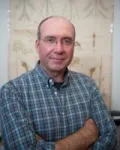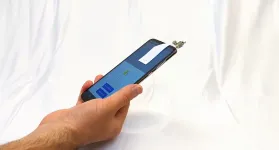(Press-News.org)
As tick season kicks in across the country, the executive director of the University of Massachusetts Amherst-based New England Center of Excellence in Vector-Borne Diseases (NEWVEC) and his team have completed research that offers a promising lead in the fight against Lyme disease.
The study, published recently in the journal Vector-borne and Zoonotic Diseases, demonstrates that the blood of the white-tailed deer kills the corkscrew-shaped bacterium that causes Lyme disease, a potentially debilitating illness. The Centers for Disease Control and Prevention (CDC) estimates that each year some 476,000 people are diagnosed with and treated for Lyme, the most common vector-borne disease in the U.S.
“Deer are vitally important to the survival of deer ticks, but they are not involved with transmitting the Lyme bacteria, Borrelia burgdorferi,” explains senior author Stephen Rich, professor of microbiology. “We’ve known for some time that ticks taken from white-tailed deer are not infected, and we speculated that something about the deer prevented those ticks from becoming infected. But until publication of our paper, no one had done the experiment to show that deer blood – specifically the serum component of white-tailed deer blood – kills Lyme.”
The results of the study may one day lead to new strategies and approaches for Lyme disease prevention and treatment, says lead author Patrick Pearson, a Ph.D. student in NEWVEC, whose upcoming doctoral examination focuses in part on this research.
“In these experiments we determined that white-tailed deer serum kills the Lyme bacterium. The next important question will be to understand exactly how deer blood kills Lyme bacteria,” Pearson says.
The research is one project of NEWVEC, which was funded by the CDC last year with a $10 million award to prevent and reduce tick- and mosquito-borne diseases in New England. NEWVEC aims to bring together academic communities, public health practitioners, residents and visitors across the Northeast, where Lyme infections are concentrated.
The Lyme disease bacterium is passed to juvenile blacklegged (Ixodes scapularis) deer ticks from mice the arthropods feed on. The infected ticks then pass the bacterium on to humans when they feed on people.
“We are the accidental host,” Rich says. “The ticks that bite us are actually looking for a deer because that’s where they breed. Without the deer, you don’t have ticks. But if you had only deer, you wouldn’t have any Lyme.”
To carry out their experiment, the researchers obtained blood serum from a semi-captive white-tailed deer herd at Auburn University in Alabama. The deer were believed to have no exposure to ticks and the bacteria that causes Lyme disease.
The researchers then grew the Lyme disease germ in test tubes and added the deer serum. “And lo and behold, it killed the bacteria,” Rich says. “Whatever it is in the deer that’s killing the germ is part of the innate immune system, a part of the immune system that precedes antibodies.”
Pearson adds, “The Lyme bacterium has proteins on its surface that protect it from the human innate immune system. Deer blood is somehow different such that Lyme bacteria are apparently unable to protect themselves from the innate immune system of white-tailed deer.”
The next research step is to determine the precise mechanisms in deer blood that kill the bacteria.
“We’d like to determine if it’s something we can induce in humans,” Rich says. “Or maybe we could use this somehow to our advantage to reduce the incidence of Lyme disease in the wild.”
END
East Hanover, NJ – March 30, 2023 –Three Kessler Foundation scientists have received grants totaling $500,000 from the New Jersey Commission on Spinal Cord Research to advance exploratory pilot studies in early intervention after spinal cord injury. Two studies will focus on areas of rehabilitation using spinal cord transcutaneous stimulation and another will test the impact of a BrainHQ cognitive training program in improving processing speed abilities shortly after SCI.
Fan Zhang, PhD, research scientist in the ...
More than 75% of patients facing amputation from the most severe form of peripheral artery disease were able to keep their limb after an innovative treatment as part of a multicenter study published in the New England Journal of Medicine.
The alternative to amputation, known as “limb salvage,” for patients with chronic limb-threatening ischemia (CLTI) came from the PROMISE II U.S. clinical trial assessing LimFlow technology and its use in performing transcatheter arterialization of the deep vein system.
The trial completed recently, and results were formally presented at the VIVA (Vascular InterVentional Advances) meeting in Las ...
According to the U.S. Centers for Disease Control, one out of every three adults in the United States has prediabetes, a condition marked by elevated blood sugar levels that could lead to the development of Type 2 diabetes. The good news is that, if detected early, prediabetes can be reversed through lifestyle changes such as improved diet and exercise. The bad news? Eight out of 10 Americans with prediabetes don’t know that they have it, putting them at increased risk of developing diabetes ...
An engineering doctoral student is shedding light on the reliability of today’s modern-day artificial intelligence with an issue most do not think about: energy efficiency.
Noel Daniel Gundi, who will defend his dissertation later in the semester, was the lead collaborator on research addressing reliability and faults in artificial intelligence. The research paper will be presented and published at the Design Automation Conference in July. It focuses on the computer chip used for artificial intelligence software, such as Google’s search engines. When at low power, the chip ...
The European Research Council (ERC) announced that Professor Jonathan Chase will be awarded one of the prestigious ERC Advanced Grants. The scientist will receive almost 2.5 million euros over the next five years to fund his research project "MetaChange". With this project, he plans to develop new concepts, tools and analyses for a better understanding of biodiversity and its change. Chase has been conducting research and teaching at Martin Luther University Halle-Wittenberg (MLU) and the German Centre for Integrative Biodiversity Research (iDiv) Halle-Jena-Leipzig since 2014.
"Jonathan ...
The Haber-Bosch (HB) process is one of the most important industrial chemical reactions. It combines nitrogen and hydrogen gases in the presence of an iron-based catalyst at high temperatures and pressures to produce ammonia fertilizer which helps provide food for over five billion people. Over the decades, researchers have tried to bring down the reaction temperature of the HB process to increase the ammonia yield while reducing energy consumption. To this end, they have recently developed new catalysts based on other transition metals, ...
BOSTON – Aging, or senescent cells, which stop dividing but don’t die, can accumulate in the body over the years and fuel chronic inflammation that contributes to conditions such as cancer and degenerative disorders.
In mice, eliminating senescent cells from aging tissues can restore tissue balance and lead to an increased healthy lifespan. Now a team led by investigators at Massachusetts General Hospital (MGH), a founding member of Mass General Brigham (MGB), has found that the immune response to a virus that is ubiquitously present in human tissues ...
A self-propagating chemical reaction can transform a liquid monomer into a solid polymer and the interaction between the propagating front and the reaction’s natural convection leads to patterns in the resulting solid polymeric material. New University of Illinois Urbana-Champaign work has shown how the coupling between natural convection and frontal polymerization leads to those observed patterns.
This research was led by a unique team of researchers- Materials Science and Engineering professor Nancy Sottos, Aerospace Engineering professor Philippe Geubelle, and Mechanical Science and Engineering ...
(Philadelphia, PA) – Greater awareness and advances in treatment have greatly improved survival rates following heart attack. With more survivors, however, has come the challenge of managing long-term impacts on heart function, especially chronic heart failure, in which the heart gradually loses its ability to pump blood.
Mortality among individuals affected by chronic heart failure following a heart attack – referred to medically as myocardial infarction (MI) – is high. But, according to new research from a major collaborative effort led by scientists at the Lewis Katz School of Medicine at Temple University, more effective treatments may soon ...
Geneva, March 30, 2023 – More than half of patients who suffer from chronic hepatitis B have the e antigen (HBeAg)-negative form of the disease. Even after many years of antiviral treatment with nucleos(t)ide analogues (NUC), lasting immune control is almost never seen. According to the current state of knowledge, those affected therefore require lifelong therapy. In the world’s first randomized controlled multicenter study – led by Leipzig University’s Faculty of Medicine and in partnership with the Centre for Clinical Studies (ZKS) – researchers have shown that many HBeAg-negative patients ...










